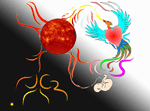« Children are luminous enigmas. »
Daniel Pennac. Children (1997). |
The birth
of the healthy mind.
of the healthy mind.
5 – From dependence to autonomy :
A - Before birth :
Brain development begins in the first months of intrauterine life and continues until about 25 years of age. The first neurons are formed from the 28th day, and then an explosive development begins : 260 million neurons are born every day until the seventh month of pregnancy. Today, the number of neurons at birth is estimated at 100 billion [see : brain formation].From the seventh week onwards, synaptic connections intensify. At a rate of one million connections per second, the maximum speed will be reached between one and three years of age, during interactions with the environment and the first learning processes.
In the fifth month of pregnancy, the increase in brain volume will also depend on the formation of the myelin sheath around the axons. This insulating sheath will allow the speed of information transmission to increase by a factor of 100 (from one meter per second to 100 m/s), an essential condition for learning.

At a time when knowledge of the world was based primarily on observation and the formulation of hypotheses, the English philosopher John Locke, in his "Essay on Human Understanding" (1690), maintained that at birth the child's mind is a blank page.
Three centuries later, discoveries in neuroscience show that learning already begins during foetal life. During this period, the taste of the foetus is formed thanks to the molecules it receives from the mother's food. It is also during this period that the foetus begins to distinguish sounds, some of which will become familiar.
It is thanks to this learning process, which began in utero, that the baby is able to differentiate its mother tongue from a foreign language within hours of birth.
« The baby's potential is developed long before birth.. »
B – After birth :
We know that the first months are times of intense neural organisation. Even if this rhythm slows down, it is considered that 200,000 new synapses are created every minute during the first years !a - The beginnings of language learning :
About twenty years ago, researchers made a major discovery that allowed them to find out that babies were not what we thought : they found tha babies between two and four days old stops moving and pay attention when the credits of their mother's favourite programme are played, which is not the case for children whose mothers have not watched this programme.
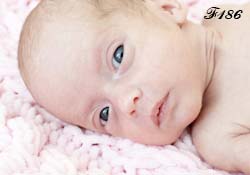
This orienting response, which shows an infant's interest in a known situation, is measured using a teat with a pressure sensor connected to a tape recorder. Using this system, other studies have shown the ability of the foetus to retain familiar sounds that it will later recognise.
After asking pregnant women to read a story aloud, the psychologist Anthony De Casper used this device, which also allows baby to choose and listen to a story by simply sucking on it : he found that almost all the infants chose the story told by their mother.
Another observation highlights this learning process in utero : from birth, babies do not cry in the same way depending on whether their mother tongue is French or German ! French babies cry with an ascending melody, i.e. higher and higher pitched, corresponding to the intonations of the French language, whereas German babies cry with a descending melody, as in their mother tongue.
b – From innate potential to specialisation :
The human infant is born with the potential to develop any ability. He can learn any language, adapt to any food, recognise any face. However, between six and nine months of age, these abilities become blunted. Far from being a regression, this phenomenon marks the orientation of the baby's skills to adapt to its environment. Nevertheless, this specialisation has its drawbacks : later on, it will be more difficult for it to learn a new language, to eat 'exotic' foods, or to accept the presence of strangers in what will become its 'territory'.
How does the orientation of his skills come about ?
We now know that, at birth, the brain is not a blank slate, it is full of possibilities. As faces look at it, as voices and smells reach it, it sharpens its senses and memorizes a lot of information. In the process, its cognitive system, oriented to the type of face it encounters every day, will gradually lose its ability to recognise the faces, sounds and smells of other cultures or even other species.
This is not really a loss but rather a reorientation of possibilities to develop a more useful ability.
For example, at six months of age, babies can distinguish between faces from their own group (Western faces for a Western child) and those from another group (Asian or African faces for example). Similarly, they can distinguish monkey faces as easily as human faces.
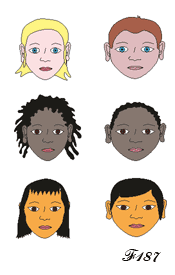 |
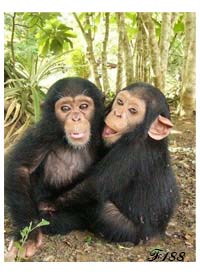 |
Easy to distinguish.
By the age of nine months, however, like adults, children can distinguish two faces from their group more easily than two faces from another group, and two human faces more easily than two monkey faces.
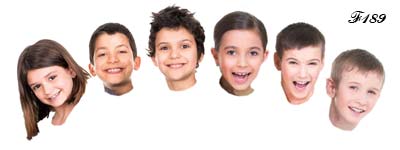
Easy to distinguish.
 |
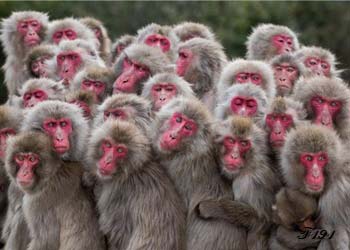 |
Difficult to distinguish.
Other studies show that the same is true for sounds : at six months, babies can easily distinguish the sounds of all languages, while at nine months they specialize in recognizing only the sounds of their mother tongue.
Monkey sounds are also accessible to infants : between 4 and 6 months of age, they are able to match two monkey sounds with the corresponding facial expressions. This ability will disappear in the following months.
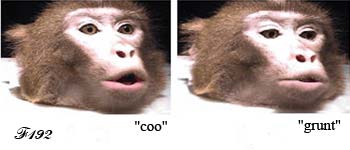
This evolution is not inevitable. Another experiment carried out by Olivier Pascalis (CNRS) and American researchers has shown that between 6 and 9 months of age, if babies regularly see monkey faces or hear a foreign language, their ability to distinguish faces and sounds does not decline.
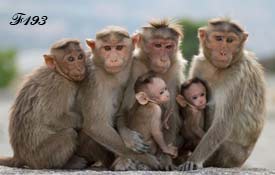 |
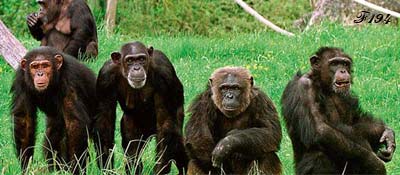 |
Easy to distinguish.
So, from birth, it is not the ability to recognise some faces more than others that a baby has, but the potential to learn to do so, thanks to brain plasticity.
Later on, it is quite natural that the child will go from having a mind open to everything to a mind open above all to the teachings of its social group.
To grow up is therefore to close doors in order to open or enlarge others, those best adapted to the framework and necessities of its life.
« To grow up is to be able to specialise one's skills
by knowing how to adapt them to one's environment and needs. »
by knowing how to adapt them to one's environment and needs. »
c – Discovering the world : crawling :
All the children's discoveries can therefore be made by observation alone. But there is another stage that will promote their knowledge of the world, an essential stage because it will free them from the influence of their environment : this is what is called "crawling".
Indeed, between 5 and 10 months, children move around on all fours. Thanks to this new mode of exploration, they will discover things for themselves, which will promote their cognitive development.
Not all babies adopt this mode of movement : some prefer to move on their bottom or stomach, or even to hold onto supports and walk : It doesn't matter how, the important thing is to be mobile.
This is what Gavin Bremner's 1978 study shows : by moving, a baby develops a less self-centred viewpoint. Other studies have subsequently shown the positive impact of this mode of exploration on the memory of actions and sensory and emotional development.
It is therefore not only thanks to their extraordinary cerebral capacities, but also thanks to the acquisition of new physical abilities that babies will discover the world around him and recognize each element.
Children's new ability to move demonstrates the innate character of their autonomy.
Thus, he does not need their parents to discover the world. They do so on their own as soon as their physical abilities allow. Only parental anxiety can hinder this discovery by making them fear an environment that could be dangerous (we know - cf : 04-thoughts - that children trust the opinions of those around them).
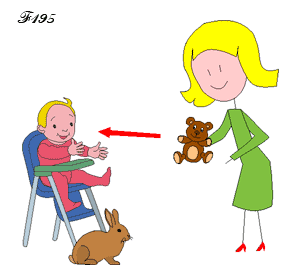 |
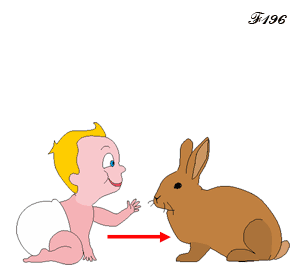 |
He waits for knowledge to be brought to him, knowledge chosen by those around him. |
He discovers for himself and forms his own impressions. |
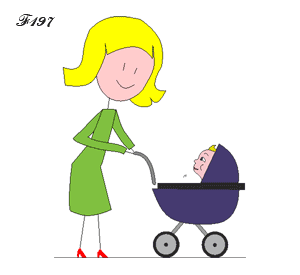 |
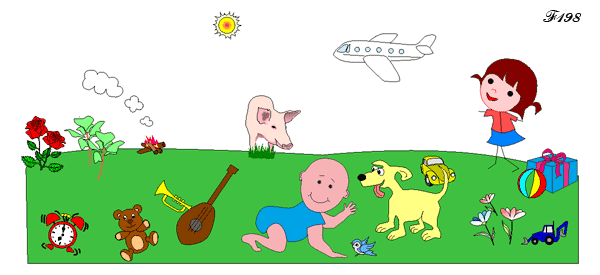 |
He sees objects and beings from a single point of view. |
IHe can approach them, touch them, smell them as he pleases. |
30 years after Gavin Bremner's discoveries, studies have confirmed the relationship between the beginning of motor skills and the development of memory and cognitive abilities in children.
It is therefore by moving alone towards the objects that surround him that the young explorer will discover the world in which he lives, in a much more enriching way than by looking at it from the top of his high chair or in his parents' arms.
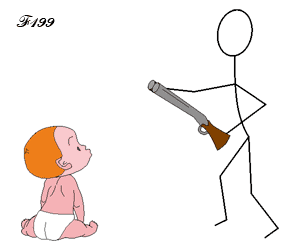 |
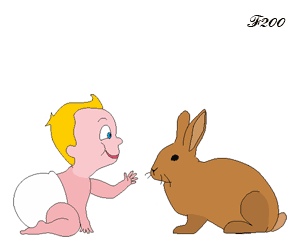 |
Induced personality... |
...or freely developed. |
He will become aware of everything he sees, hears and touches. He will develop his own feelings, mistrust, confidence, outside of any external influence. He will thus forge his own personality.
Apart from simple discovery, this mode of exploration also changes the way the baby interacts with the world. From all these new experiences, he extracts the important elements : for example, the functioning or solidity of the toy that attracted him. He can also adapt previously acquired knowledge to this new context.
Moving around on all fours, while developing his physical abilities, is above all an intellectual stage.
Their memory thus acquires great flexibility, which is not the case for children who have not been able to explore their environment freely.
These findings help us to understand the amnesia of the early years [see : memory], because the memory is not yet structured.
Another hypothesis is proposed by Jacques Vauclair, professor at the University of Aix-Marseille. For him, infantile amnesia is linked to the way in which the child has experienced events. In fact, when placed in an environment that reproduces the initial conditions, the child can remember very well.
Children have a bodily and emotional memory that has not yet been replaced by memories of the events, memories that have been dissociated from their experience [see : The cathartic treatment].
In an experiment carried out by Gavin Bremner in 1978, children had to find a hidden object. They succeeded at around 8-9 months, provided they could move around and thus change their point of view.
Monkeys pass this « object permanence » test much earlier than babies, because they acquire autonomous locomotion much earlier than human children. Autonomous movement develops a whole range of cognitive abilities : object recognition, spatial location, memory of actions, development of the senses and emotions.
At the same time, grasping also takes place : the appropriation of objects becomes possible.
The duration of the "four legs" is generally short, the time it takes for the legs to carry and allow walking.
Children naturally moves from crawling to standing upright because, while moving in space, they improve their strength and develop their senses. By trying to see things from higher up, not only expand their vision, but also improve their balance. By exploring their environment, they discover for themselves objects that can help them to stand up, and other that were hidden. It is therefore by themselves, and without assistance, that they will one day stand up.
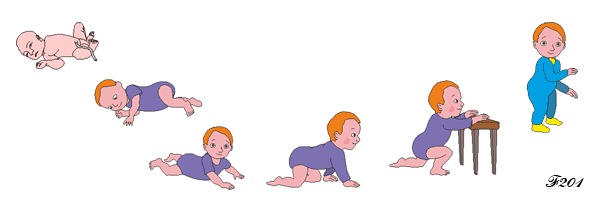
The autonomy of babies by moving on all fours is an essential stage in its development. It is at this point that they can learn by themselves, thanks to all the capacities bequeathed by evolution.
It is the first opportunity to free themelves from the influence of their environment, opportunity which makes them discover the world as they should know it.
Indeed, depending on the way of life of this environment, they may acquire respect for everything or, on the contrary, be attracted by money and even weapons.
« A change of perspective is essential
for the development of cognitive abilities. »
for the development of cognitive abilities. »
d – The integration of the baby in a dangerous environment :
Imitation is an innate capacity, indispensable to infant's development, as it allows them to do their own learning.
To imitate, mirror neurons are indispensable [cf : the use of analogies-in french]. Since their discovery in 1990 and their role in imitation, other studies have confirmed their importance in another ability : empathy.
But infants are not ready to imitate someone they do not trust.
1 - Learning through trust :
Although it has long been known that newborns have very early skills, they have been compared to sponges that absorb everything they perceive.
Three researchers from Concordia University in Quebec (Rachel Baker, Tamara Pettigrew and Poulin-Dubois) have discovered that newborns are very selective about who they learn from : they quickly identify credible role models and only imitate someone who is honest and reliable.
To conduct the study, the three researchers gathered 60 infants, aged 13 to 16 months, who were observing adults. In the first part of the experiment, these adults look into a box and show great pleasure. Then the children can check the contents of the box and see if it really contains such a source of joy (in this case, a toy), or if it is empty.
Through the feeling they got (disappointment or pleasure of discovery), the babies could assess the credibility of the adult.
Then the adult flips a switch with his or her forehead to turn on a light. Will this behaviour be imitated ?
61% of the children who were confronted with a reliable adult imitated him or her, compared with only 34% of those who had been deceived.
Like young children, babies know the difference between right and wrong, and they use their newly acquired knowledge in later behaviour. If they perceive someone to be unreliable, they deliberately choose not to learn from him or her.
These evolutionarily selected skills are easily explained because, in order to survive in an often dangerous environment, it is better to have confidence in the models one is willing to imitate.
2 - Learning through emotions :
- Attention to faces expressing fear :
We know that, from three months, babies know how to use the gaze of adults towards certain objects to trust these objects.
However, up to five months, despite their interest in faces, babies still look indifferently at expressions of joy and fear : they do not yet detect signs of fear.
At around seven months, however, they look more closely at a face expressing fear.
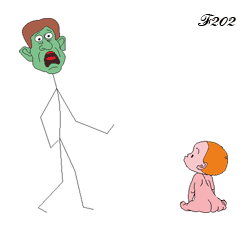
Mikko Peltola, from the University of Tampere in Finland, has shown that from this age onwards, babies lingers longer on a face expressing fear than on a neutral or happy face. Their eyes remain riveted on the face, no matter what objects are presented to them to distract them. They discover the existence of danger, and the means to prevent it.
Detecting joy, fear, or anger in the attitude of others thus allows them to respond in a way that is adapted to the situation, to better escape the danger. This ability is of paramount importance the babieswho do not yet know all the dangers that await them.
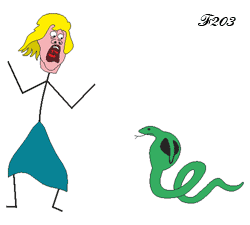
The researcher also measured the electrical activity of the brain areas dedicated to attention while the babies were looking at faces of fear and joy.
At five months, there is no difference in activity between the two expressions, but at seven months, on the contrary, these areas are much more solicited while looking at a face marked by fear.
- The interest of alliance in escaping fear :
How can this late reaction be explained ? It seems to be essential for survival.
The chronology, inscribed in evolution, is, once again, coherent : knowing the danger is useless when we can neither flee nor defend ourselves. Before trying to react, it is necessary to know who we can trust and who can help us. On the other hand, it is smiles that welcome babies from birth rather than expressions of rejection.
Then, this relationship of trust is completed by the attachment to the person. Babies can then explore their environment and make the connection between the objects around them and the facial expression of the protector.
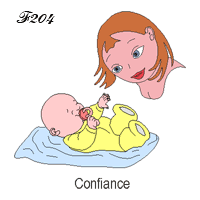 |
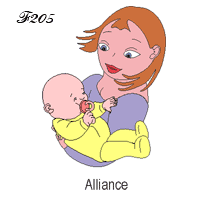 |
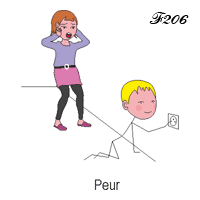 |
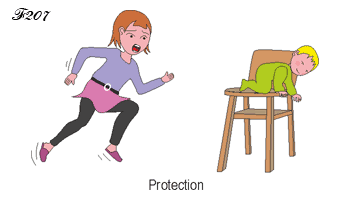 |
Other researchers (Tricia Striano, from New York University) have shown that babies' attention is drawn to an object all the more because they have read the fear in the adult's eyes.
This mechanism appears as early as three months of age, well before they are able to react to any threat on their own.
Adults therefore have an essential role to play in their child's learning, and it is often without being aware of it that they influence their child by sometimes communicating their own fears.
Indeed, by their very looks, they give an emotional touch to all the objects around them.
Thus, the baby can be misled by the adults' reactions and integrate false information about a small danger that amplifies the adult's unreasonable fear.
However, an exception to this is that babies have been found to be instinctively afraid of spiders, without adult input.
- Attention to anger :
In another study, Tricia Striano compared the brain responses of seven-month-old babies to fear and anger : they paid more attention to the expression of anger as if it sent them a stronger signal of insecurity. Is this because it is felt as a direct threat that babies cannot escape ?
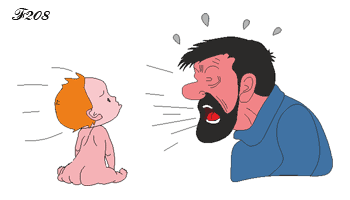
« Like baby, like adult. »
C – The integration of the baby into the social world :
a - Theory of mind :Until recently, child specialists thought that infants, before the age of four, did not have the capacity to grasp that the thoughts of others might be different from their own.
To study this ability, researchers showed babies videos in which a ball rolls behind a screen, disappears from view and then reappears. An expressive character observes this movement. The researchers found that babies spent more time watching scenes where the outcome did not match the character's expectations.
It is now considered that infants as young as seven months of age possess this ability, known as "theory of mind".
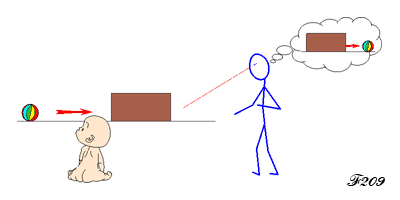 |
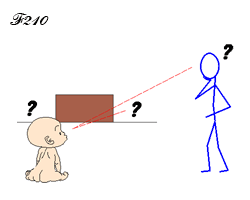 |
The children who had experienced the opaque blindfold expected the actor who could not see to misjudge the location of the object, but the other babies did not. They thus showed that the babies used their own visual experience to attribute knowledge to the actor.
b – Moral skills and sense of fairness :
Whether or not babies is concerned by a scene that is unfolding before its eyes, whether or not it knows the actors or their motives, they are capable of judging behaviour.
This is the result of an experiment conducted by Karen Wynn and her colleagues, researchers at Yale University (USA). They presented babies aged 6 and 10 months with wooden toys representing small characters.
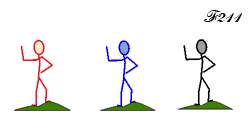
Initially, sitting on their parents' laps, the babies watched videos in which these wooden characters were played.
Two videos show one of them trying to climb a hill. In the first video, a second character, playing the role of the bad guy, pushes him away, so that he falls back down the hill. In the second video, he is helped and pushed by a character who helps him to climb to the top of the hill.
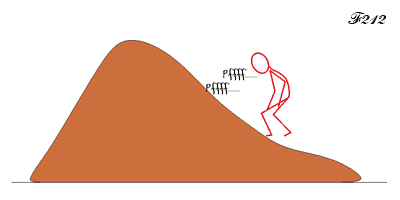 |
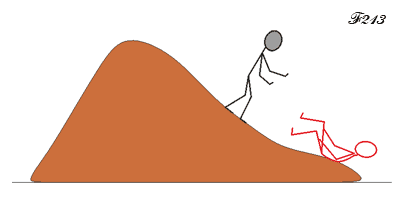 |
 |
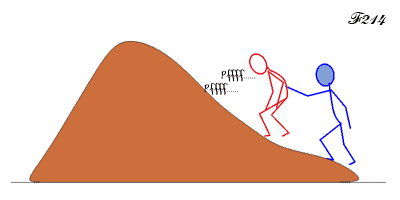 |
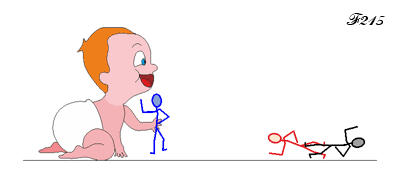
In a second phase, the researchers introduce a neutral character, whom the babies have not yet met.
When given the choice between the nice character and the neutral, the babies prefer the nice one. However, when they have to choose between the neutral character and the bad guy, the neutral character is preferred !
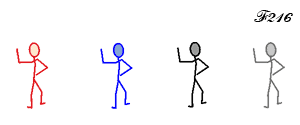
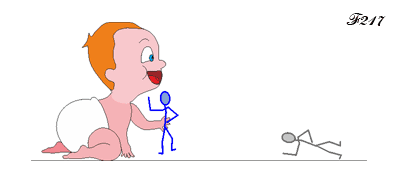 |
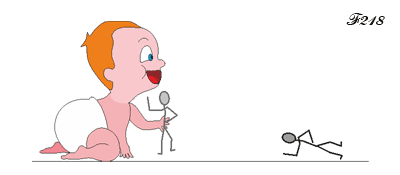 |
Finally, in the third stage, the three little characters are all put together. It is then that the one who was trying to climb the mountain approaches the bad guy, leaving the good guy behind. While the 10-month-old babies express surprise at this choice, the six-month-olds do not react : it seems that they are not yet capable of projecting their own intentions onto the behaviour and attitudes of others.
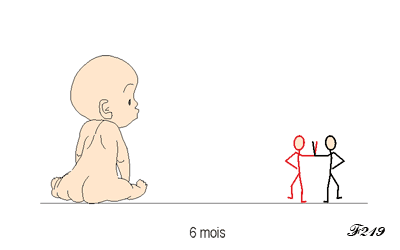 |
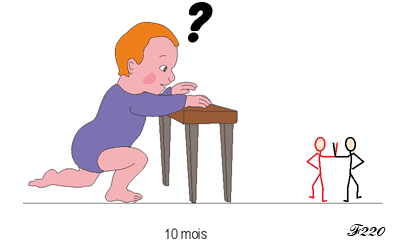 |
Babies preference for the good guys seems to be the basis of their later moral development.
Not being involved in the interaction between the characters himself, they acts a an impartial witness.
His 'moral sense' and the choices they make are primarily determined by what affects them personally.
These choices, if they could be maintained over the course of their life, could be a factor in the transformation of society as they would naturally sideline the 'bad guys'.
It is this ability to define people by their actions that would allow the construction of morality and ethics.
However, it is not clear whether babies are already capable of distinguishing between what is good for them and what is good in general.
Do babies judgement concern only real people, objects representing characters or only their actions ?
The researchers went further : do babies attribute intentions to people through emotional expressions or does the act alone determine their choice ? To obtain an answer, a Japanese team presented 10-month-old babies videos showing geometric shapes in different situations.
After seeing a blue circle rushing towards a yellow square and violently colliding with it, the babies preferred the "victim", in this case the yellow square, in 75% of cases. If there is no interaction between the geometric shapes, they choose one shape or the other.
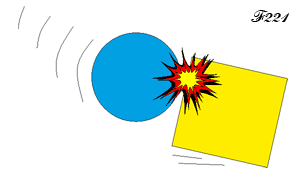
In the previous experiments, did the babies feel compassion ? In the videos involving geometric shapes, no pain is expressed, no sound expressing pain or fear guides the baby's response.
Rather, it is the perception of danger that may later determine survival behaviour : for example, if an unbalanced rock falls on a human fellow, it is advisable to avoid unbalanced rocks. Babies are content, in this respect, they enjoy the benefits of evolution in all living beeings.
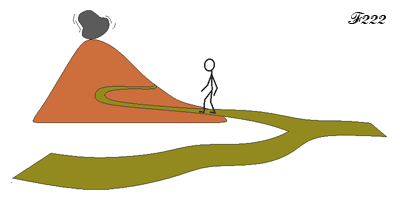 |
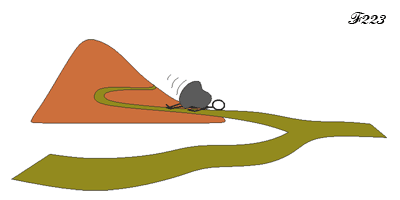 |
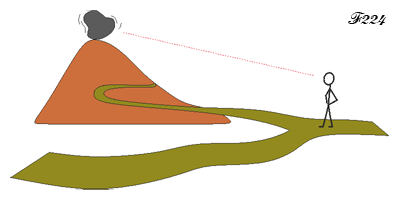 |
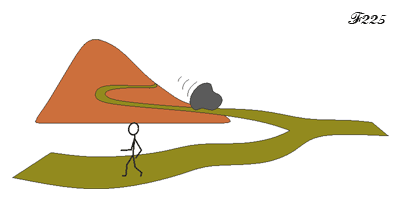 |
Similarly, it has been shown that sensitivity to moral standards is early. For example, Stephanie Sloane, a psychology researcher at the University of Illinois, showed in 2012 that babies aged between 19 and 21 months react more when a single puppet is given two toys, while the other is given none.
The researcher also showed that a sense of fairness is apparent even earlier, from the age of nine months. She looked at their reactions when certain members of their group are favoured, for example when a reward is given to two people when only one has earned it. She found that babies expect individuals to support each other.
This analysis is consistent with a growing body of research indicating that babies already have a set of mental representations of what constructive relationships between members of the same community should be. This will help them to find the right behaviour for integration into any community.
c - Emotional skills - empathy :
Another study, published in 2011, showed that, from the very first months, babies detect emotional resonances in human sounds.
To reach this conclusion, researchers used MRI scans to measure the brain activity of sleeping infants aged three to seven months while happy, sad, neutral or human sounds were played.
The researchers found that an area of the temporal cortex that processes human vocalisations in adults was activated when neutral human sounds were heard. Similarly, brain areas involved in emotional processing responded when laughter and crying were broadcast.
In these findings, researchers see the first steps towards empathy. However, although understanding of the emotional state of others seems to be in place by the age of nine months, it will not be fully affirmed until 14-18 months [see : Empathy].
d – Anticipation :
1 – Anticipation of gesture :
When it is only a question of observing the behaviour of our fellow human beings, everything seems easy, but everything becomes more complex as soon as it is a question of anticipating their actions. This is the challenge that every newborn baby faces.
Once its brain has sufficiently matured, it will be able to predict the actions of those around him, and determine their intentions. It begins to acquire this ability at the age of six months. This discovery is the result of a study conducted by Terje Falck-Ytter, a researcher at the Karolinska Institute. He asked babies aged between six months and one year to watch videos in which an actor grabs toys and puts them in a box.
The experiment consisted of following the children's eyes : the one-year-olds looked towards the end of the action, anticipating it as adults do, but the younger children did not.
How does this new ability evolve ? Mirror neurons play a major role.
At the age of four months, babies can be considered capable of grasping an object with their full hand. By observing their mother, they quickly learn to do as she does.
The mirror neurons, having memorised the gesture, allow it to be transposed into the baby's own muscular system.
However, in order to predict the actions of others, one must first be able to perform them oneself. It is then that the child can predict the finality of an action performed by others. Experience is essential.
This is why, at one year of age, the experiences accumulated since birth enable childen to look in the right direction and follow all the circumstances of an event, since they already know the outcome of the scene he is witnessing.
Moreover, thanks to the mirror neurons, they perceive the meaning of gestures even before communicating through speech. The social link is established.
We have already learned about this process in which performing an action or imagining it activates the same motor areas in the brain.
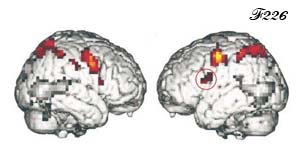 |
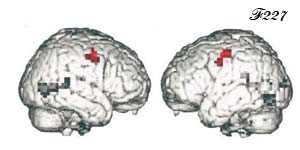 |
Action performed. |
Mimed action. |
Through observation, learning will take advantage of this ability to see which actions are beneficial or harmful, before imitating them. Parents will then have a major role in their child's future depending on the example they set.
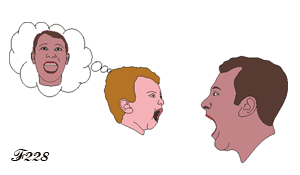
Observation and visualisation.
Later, the language neurons will carry out an identical process : on hearing the description of a scene, the mirror neurons will convert the sentence into a motor representation of the scene.
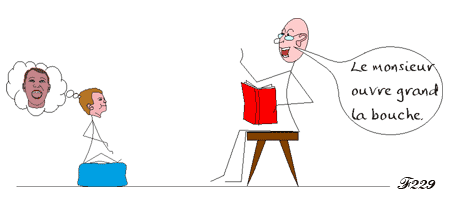
Observation and listening.
2 – Anticipation of emotions :
We know that adults use their experience to analyse a situation, understand its advantages or perceive a danger. The same is true for the baby : seeing a gesture and being able to imitate it enables him to grasp its meaning..
Similarly, being able to feel what an emotion is - pleasure or disgust - helps to identify and understand the person expressing it. For example, babies will be able to make assumptions about the end of a cartoon if they have already experienced the emotions of the characters.
This is why, at around one year of age, babies can anticipate the simplest actions, because they have acquired and mastered them themselves.
Why so late when we know that from three months onwards, they are capable of anticipating the movement of an object, for example a ball ? Because there is a functional difference in the brain between anticipating the movement of an object and anticipating a human action. The movement of an object depends on a system based on physical properties of the world [cf : an intuition of physical laws], not on social properties.
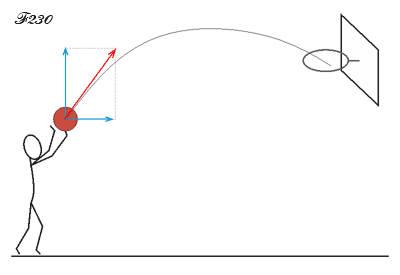 |
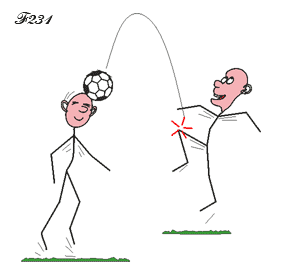 |
Movement of a ball. |
Gesture of a human. |
In our species, sensory and motor development are staggered. Unlike most animals, babies do not walk as soon as they leave their mothers' wombs, because their motor action is delayed : it does not come into play until around five or six months.
Despite this, as early as two months of age, babies are able to modify its environment because they influence the behaviour of those around them. To do this, they use their imitation skills, which arouse emotional reactions in those around them.
At two months of age, for example, they establish a dialogue with their mothers because they can see the results of their own gestures and mimicry in her : they are already showing a certain level of foresight. When the two are in different rooms, united only by a television screen, babies are happy if they can continue to communicate with their mothers. But if the screen broadcasts a delayed recording that shifts the emotional dialogue, they smile less and then gradually loses interest in the screen.
However, at the same age, they do not perceive the difference between the live and the recorded dialogue if they do not know their interlocutor. Indeed, babies cannot generalize this system of emotional exchange when they have not yet spotted the signs of communication in their interlocutor. In this case, they will only be able to do it at six months.
For the same reasons, babies cannot tell the difference between direct communication and a recorded film when their mother is depressed, because the difficulty of getting her attention has not yet enabled them to learn to influence her and communicate.
When do babies move from predicting an action to predicting an emotion ?
It is currently thought that this ability to attribute mental states to others (desires, intentions, etc.) may appear around 15-18 months.
Later, the expression of emotions will be completed by a verbal exchange. It is then that spontaneity will start to be controlled and replaced by rules of conduct.
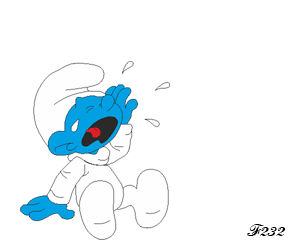 |
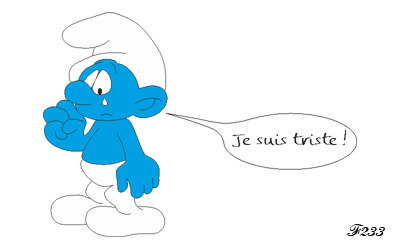 |
Emotion is expressed through body language. |
Language completes or replaces the expression of emotion. |
« Perceiving is already acting »
e – Role of education :
So what role does society play in the process of empowering children ?
We have seen that evolution has already enabled them to establish a basic classification : nice and nasty characters, trustworthy or not, pleasant or painful relationships.
In the same way, as they grow up, they need to classify the objects in their environment according to categories that enable them to build a structured world, to adapt to different situations and to understand them : big - small, girl - boy, maternal behaviour - paternal behaviour - social behaviour, etc.
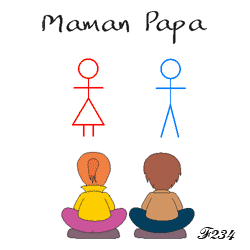 |
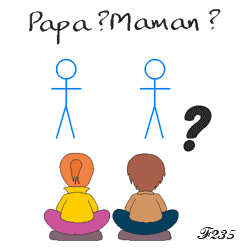 |
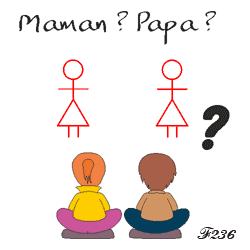 |
The forbidden is also a structure that children need to access autonomy in the community. However, today, some societies no longer assert authority, whether from parents or teachers : this will prevent children from understanding the importance of hierarchy. Will they find their place in society ?
When childdren lacks pre-verbal authority (through facial expressions), then verbal authority (when forbidden to do as they wish), they end up forgetting that their desires are not always those of the other person, and so, do not learn to renounce their own will in order to open up to the other person's. Then, they run the risk of behaving like dictators.
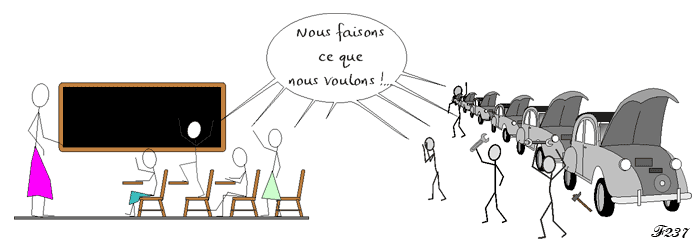
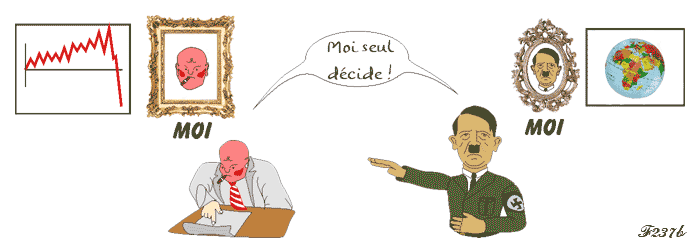
While they also learn not to bite or hit as they would spontaneously, thus testing the reactions of his 'opponent' during his games, how could their capacity to experience what they make the other person feel develop ? If their spontaneous learning to live does not allow them to fully decentre themselves and put themselves in the place of the other, how will they develop their capacity for empathy and manage to integrate into a group ?
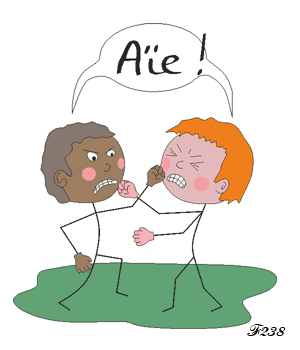
A more insidious form of violence can also affect children : emotional neglect. Some parents do everything they can to satisfy their children's material needs, forgetting to fulfil their emotional life. The suffering caused by emotional loneliness, in an environment that satisfies all needs, and sometimes more than necessary, is the one that leads to the most neurobiological, psychological and behavioural disorders.
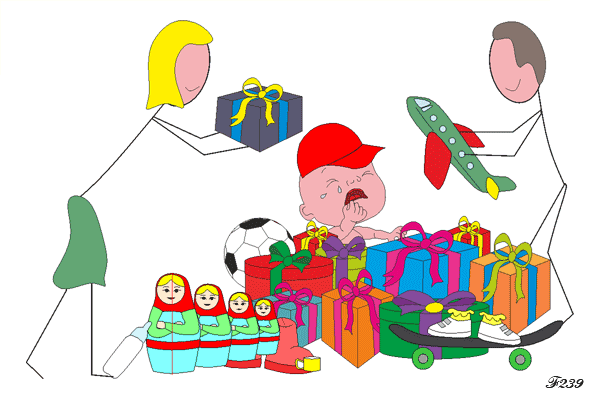
« Like adult, like baby ! »
Finally, scientific progress could well provide us today with the "zero defect" baby. These children are designed to reassure mentally fragile parents. Yet it is the only chance that allows psychological autonomy and the recognition of otherness.
It is indeed much easier to accept oneself as imperfect, and to love imperfect children, than to dream of the perfect child who will inevitably disappoint.
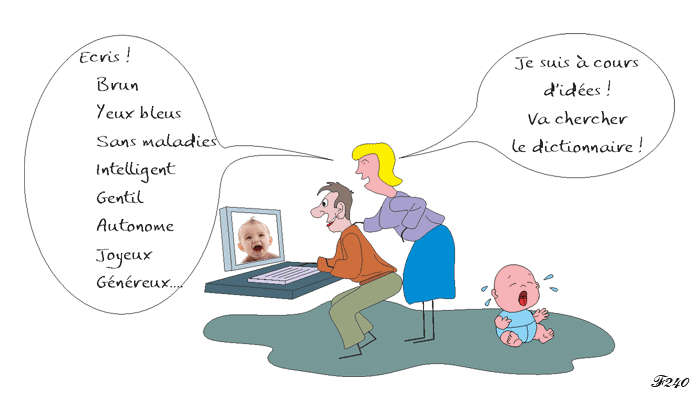
« Perfection does not exist,
but everything can be improved, »
but everything can be improved, »
D - The key stages towards autonomy :
What are the babies' skills, then, before they come under adult influence and integrate into the social world ?– Senses and motor actions : (birth to two years)
Jean Piaget's studies, on object permanence, enabled him to define a first stage in the construction of intelligence : the sensorimotor stage, which develops from birth to the age of two.
During this period, the baby interprets the world through its five senses and progresses through the evolution of its motor skills. It discovers the physical rules that govern him and its possibilities of action.
– Imitation : (two days)
In the field of emotional perception, Andrew Meltzoff and Keith Moore had the idea, in 1977, of showing different emotions to newborns under two days old. They found that the newborns were able to imitate them. It was only 20 years later that the existence of "mirror neurons" was discovered.
– Adaptation to the environment : (three days)
Using a virtual treadmill, French researchers succeeded in inducing walking in three-day-old babies held in the air. This discovery shows that, from birth, babies have the ability to adjust their body activity to what they observe.
– Social adaptation : (early days)
Social skills have also been demonstrated from the very first days.
For example, one study involved a baby interacting with its mother via a screen. When the live image was replaced by a recorded video, the baby was disturbed by the discrepancy between his facial expressions and his mother's reactions.
– Communication : (two to three months)
At two months of age, babies activate the same region of the brain as adults for the perception of faces.
Another neural circuit whose organisation is similar to that of the adult has been highlighted by Ghislaine Dehaene : it allows, from the age of three months, to identify the repeated elements of a sentence.
– Object permanence : (three to five months)
For Piaget, a baby had to move to discover that an object continues to exist even if it cannot see it. This could only happen at around 18 months.
In 1985, the American psychologist Renée Baillargeon, by observing how long babies pay attention to a situation, discovered that they acquire this ability from three to five months.
– Calculation : (four months)
From the age of four months, babies solve simple additions, such as 1 + 1 equals 2 or the subtraction 2 - 1 equals 1, like great apes.
This numerical ability has been demonstrated by measuring visual fixation time. For example, the experimenter puts two balls in an empty box and takes out three. Babies look longer when there are unexplainable differences in the number of objects.
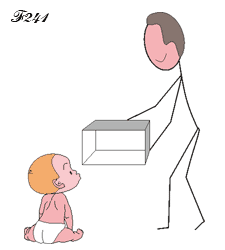 |
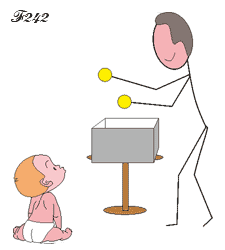 |
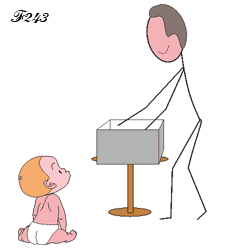 |
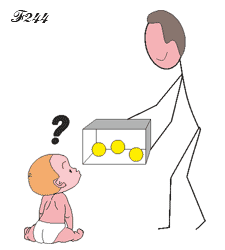 |
- Recognition of the mother tongue : (Four to eight months)
Long before they speak their first words, babies are able to distinguish their mother tongue from other languages.
We know that the language areas appear as early as three months of age, but they are not the only ones that are active. For example, when children aged four to eight months are shown a silent film, they react when the actor changes languages : they are aware of this not by sound but by the movement of their lips.
- Moral sense : (Six months)
In 2007, a study by Karen Wynn showed that babies are able to assess the behaviour of others at an early age. In a puppet show where characters come to the aid of a third character or knock him down, babies show a preference for the helping character as early as six months of age.
– Inhibition : (12 months).
A baby is placed in front of a teddy bear and two cushions A and B. To start with, the teddy bear is hidden under cushion A : at eight months the baby finds it easily.
Then, the teddy bear is hidden under cushion B : until the age of 12 months, the child continues to look for it under cushion A, showing its inability to inhibit its former knowledge. It is not until the child is 12 months old that it becomes able to inhibit known behaviour.
This experiment shows that intellectual development requires the ability to inhibit previously acquired motor and cognitive acts in order to perform new ones.
– Logic and discernment : (14 months)
Another study, published in 2002, showed how babies reason.
When an adult shows them a new strategy for completing an activity, 14-month-olds only use it if they find it more rational and effective than the one they know. This means that they do not just mechanically reproduce what they are shown, but use their own judgement.
–Theory of mind : (15 months)
Around 15 months, infants discover that others may have their own intentions and knowledge. A 2005 study demonstrated this by observing infants watching an adult arrange an object in different boxes. If the adult looks for the object in the wrong box, the baby looks at this unexpected situation with more attention.
«Not only does the baby have the basics of adult behaviour,
but, being able to discern, he can discard outdated behaviour.»
but, being able to discern, he can discard outdated behaviour.»
6 - Child's consciousness : (continued)
06 - La conscience de l'enfant : (in french)

